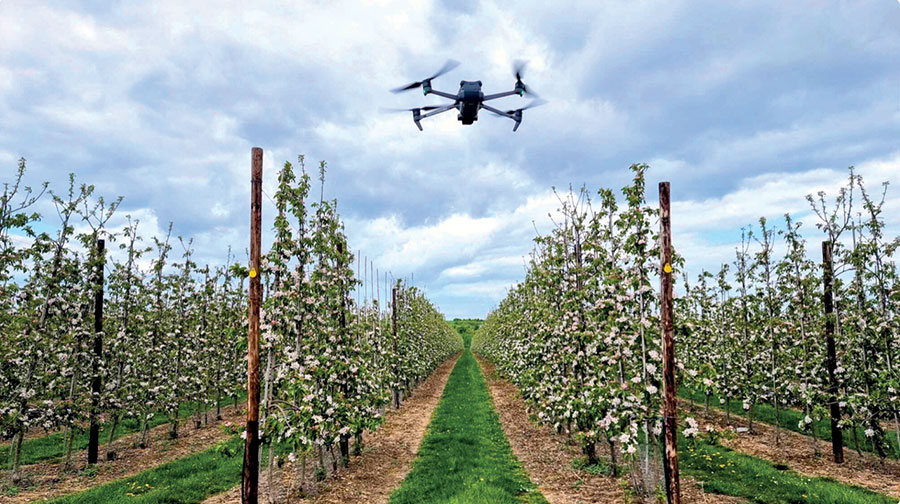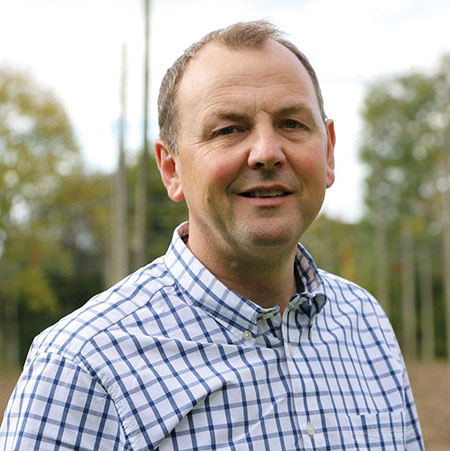The importance of pollination
13th May 2024
Good pollination has multiple benefits for orchards, but is it being overlooked given the widespread popularity of self-fertile varieties and pressure on margins? Fruit & Vine asks the experts for their advice.

From increased yields, higher dry matter and better storability, to improved size, taste, and colour, there are many benefits that good pollination brings to apple orchards, says Kent-based Hutchinsons agronomist Rob Saunders. Another is to improve the efficacy of chemical thinning agents.
“Historically, when Cox was widely grown, much effort was needed to ensure orchards were pollinated effectively, but with modern varieties like Gala, Jazz, and Candy, that reliably set fruit, growers tend not to worry about pollination as much.”
That is a mistake though, as the benefits from proper pollination, which results in more pips per apple, are well-proven, even in semi-self-fertile varieties, he says.
“Because modern varieties will set fruit with very few pips, pollination has almost become a hidden issue.”
Assessing pollination
Measuring pollination is tricky though, especially as it is influenced by so many factors, says Hutchinsons agronomist Nigel Kitney, from Herefordshire.
Bud and flower size can provide a crude indicator of likely success though, as larger, stronger flowers are generally more likely to be pollinated, he says.
“The size of flower trusses does vary between one and two-year-old wood. Generally, terminal buds are strongest on both, but flowers on shoots of one-year wood tend to be weaker, which can follow through to fruit size at harvest – generally, the weaker the blossom and smaller the flower, the smaller the fruit, and vice versa.”
Companies such as Outfield are able to digitally map blossom intensity across the orchard using drones, and research is underway to take this to an individual tree basis.
Improving pollination
There are several steps growers can take to improve pollination, as detailed below:
Get nutrition right
Nutrients, principally nitrogen and boron, are key to effective pollination, so Mr Kitney recommends regular tissue analysis to avoid deficiencies. “The viability of female flower parts depends on how well fed the fruit bud is during the previous growing season. A shortage of nitrogen in the rosette by green cluster reduces the longevity of the ovule, while low boron reduces the speed pollen tubes grow.”
Tissue testing needs to be done early though, allowing any remedial action before it is too late, he continues. Ideally, leaf analysis should be done in August so nitrogen plans for the following spring can be put in place, and foliar boron applied immediately post-harvest. “You may still see a small impact from applying boron at green cluster or even pink bud, but you certainly can’t wait until flowering, as it’s too late by then.”
Mr Kitney also highlights previous research from Long Ashton, that showed August/September nitrogen applications greatly increased fruit set the following season. “But with canker-prone varieties, doing so increases the risk of canker on leaf and picking scars in autumn. The skill is to make sure general nitrogen nutrition is adequate throughout the season, not excessive, or inadequate.”
Thin early
The timing of thinning has a huge impact on blossom strength the following year, says Mr Kitney. “Generally, the earlier you thin, whether chemically or by hand, the stronger the return bloom and fruit buds the following year. Ideally, thinning needs to be done during June, and certainly before the end of July, as fruit buds are formed by then.”
Encourage pollinating insects
Introducing supplementary hives during flowering, helps pollination, but Mr Saunders says growers should also consider how well the landscape supports pollinator populations throughout the year, particularly during the “June gap” when spring flowering has finished and summer flowering is yet to get going.
“There may be opportunities within the Sustainable Farming Incentive (SFI) to increase floral resources to provide a continuous pollen and nectar supply.” Ground-nesting solitary bees have been shown to be particularly good pollinators, while bumble bees are also effective, and Mr Kitney says both may have a wider window of activity than honey bees, which are usually less active in cooler conditions (typically <15ºC). Hawthorn flies and non-pest species of weevil are other useful pollinators.
Add pollination partners
Having additional pollinating varieties, such as Jester, Golden Delicious, Granny Smith, or Malus, in the orchard can greatly improve pollination, even among self-fertile varieties, says Mr Kitney. “The pollen tubes of pollinator varieties always grow faster and give a greater number of seeds than if you only have a monoculture, even if they are self-fertile varieties.”
The benefits are most obvious in cold springs, when pollen tubes grow more slowly and may fail to reach the ovule in the flower, causing it to abort. Trials at the Hutchinsons HELIOS site have found Jester to be an excellent pollinator variety for Gala-type apples, he notes. “We’ve found Jester gets there much quicker than other varieties, so in a poor spring you’re far more likely to get successful pollination if you’ve got it as a pollinator.

“We’re not taking a crop from pollinator trees, so at HELIOS they are planted against the large trellis support posts and pruned back hard after flowering to encourage them to spur.” He suggests orchards need at least two different pollinator varieties to mitigate seasonal variations in flowering, planted at a 1-in-10 spacing along every row.
“Growers often worry it’s not cost-effective to have trees that aren’t going to be cropped, but orchards with more pollinating trees do yield better than a monoculture. So, even though you are harvesting from fewer trees per hectare, by including more pollinator trees, you get more reliable and effective pollination, and more regular sales of good quality apples.”
Alongside flowering timing, growers should also consider any pest or disease risks when selecting pollinators, as many varieties are more susceptible to scab or canker, and some harbour pests, such as woolly aphid.
Control bourse shoots
Bourse shoots appearing at the base of flowers and buds indicate trees are diverting energy into shoot growth, rather than setting fruit, but this risk can be managed by applying the PGR prohexadione calcium as soon as shoots are 10–15mm long, advises Mr Kitney. Where growers are particularly worried about fruit set, he recommends including gibberellic acid (GA4+7) with prohexadione to boost the flow of nutrients into flowers during pollination.
Spur extinction
Artificial spur extinction (ASE) is another practice that, research has shown, can improve the proportion of flower buds setting fruit.By selectively pruning and removing some floral buds in winter, growers can direct more carbohydrates and nutrients into fewer, stronger buds and better balance the floral supply with the available pollination resource in the orchard. Indeed, trials in New Zealand a few years ago found the technique significantly increased yield and quality of Scilate apples grown on tall spindle trees, although it is not something UK growers have adopted.
Pollination is key to thinner efficacy
Good pollination is crucial to efficacy of chemical thinners, which rely on differentiation to work effectively, says Rob.

“The main thinners used in the UK work by manipulating supply and demand, either by inhibiting leaf function to reduce carbohydrate availability, causing a proportion of fruit to drop, or by stimulating cell division of fruit growth so that once it reaches a ceiling of carbohydrate availability, some fruit are dropped as they get outcompeted.
“Both modes of action rely on hierarchy, where stronger fruit are favoured. If you’re growing a monoculture with poor pollination and no differentiation between fruit, that competition effect is much less defined and thinners don’t work as well.
“Good pollination is unlikely to ever give you five pips in every apple pollinated, but you might achieve a situation where some have five, and some have one, giving you the differentiation needed for thinners to work.”
Read more fruit news
